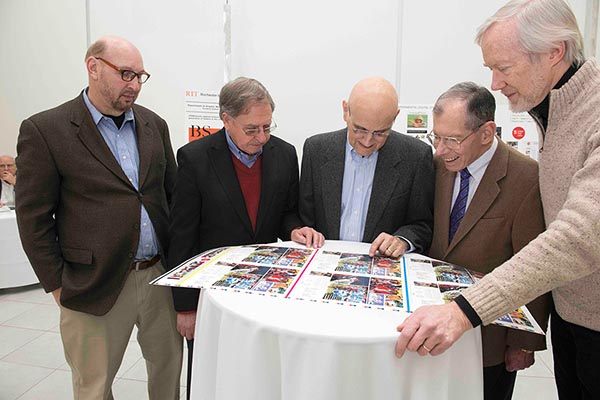
Peter Crean (center) with colleagues Henry Freedman (Image Test Labs), Peter Dundas (Image Test Labs), Robert Eller (Rochester Institute of Technology), and Eric Zeise (Image Test Labs).
The graphic communications industry lost one of its most groundbreaking technologists with the passing of Peter A. Crean on December 23, 2023.
He died in Rochester, N.Y., just hours before the death of Dorothy Crean, his wife of 55 years.
The holder of a doctorate in nuclear physics from Princeton University, Crean joined Xerox Corp. in 1970 as a scientist at the company’s research center in Webster, N.Y. Over the next four decades, he developed or co-developed many of the technologies that became the building blocks of digital printing and imaging as it exists today.
In 1970, for example, he was one of three members of an engineering team that produced the first laser printer. At the beginning of the list of 40 patents he created for Xerox was the company’s first high-quality, high-speed CCD document scanner. He would go on to make fundamental contributions in nearly all areas of production printing and imaging for Xerox, from which he retired in 2010.
The inventions named in Crean’s patents suggest the scope and complexity of his research. For example:
- Hybrid single-pass, multi-pass full color printing system
- Methods to control appearance of gloss levels for printed text and images
- Page parallel raster image processing
- Minimizing spectrophotometer impact on spot color accuracy
- Page parallel RIP with interleaved chunks
- Pipelined architecture for patterned halftone generation
- Inkjet printer droplet height sensing control
Innovations Under the Hood
Crean and other Xerox researchers found a way to run imaging and compression algorithms for variable printing on high-performance video chips—an application that yielded higher print speeds and better imaging quality at lower cost. Advancements like these underlay the success of Xerox products from the landmark DocuTech 135 Production Publisher to the equally iconic DocuColor iGen3 Digital Production Press.
“We’re saddened to learn about the recent passing of Dr. Peter A. Crean, who joined Xerox in 1970 and worked as a researcher for over 40 years,” said Justin Capella, a spokesperson for the company. “A pioneer of printing technology, Dr. Crean’s legacy leaves a lasting impact on Xerox.”
“I loved working with him,” recalled Frank Steenburgh, the Xerox sales executive who led the market launches of the DocuTech and the iGen3. Whenever technical questions arose, “he always either understood or found out and got back to me. He could communicate. I trusted him.”
A particular gift of Crean’s, said Steenburgh, was his ability to translate technology from the lab into real-world applications “in a product that was ready for the market.” He is remembered at Xerox as one of the first engineers to incorporate sales team and customer feedback into the development of new technologies.
After retiring from Xerox as a Senior Research Fellow, Crean partnered with Henry Freedman, an expert in imaging and print sciences, Dr. Peter Dundas, a former principal color scientist for Xerox, and Eric Zeise, a research scientist for Eastman Kodak, in Technology Watch–Image Test Labs, a developer of image and color measurement tools for print applications.
There, he was part of a project that for the first time measured the ability of digital printing to match, and even exceed, the quality of offset lithography throughout a print run. In 2017, the Image Test Labs team received an InterTech Technology Award for ImageGrader™, a system that speeds and simplifies the assessment of image quality of offset and digital presses.
A Legacy to Remember
Crean was the 2009 recipient of the Robert F. Reed Technology Medal from the Technical Association of the Graphic Arts (TAGA). The award recognizes scientists and engineers who contribute to significant improvements in the graphic communications industry.
According to Freedman, the top three “fundamental game changers” of Crean’s career were the technical innovations he brought to the development of laser printer, the multifunction printer (MFP), and to what Freedman says was the first B2-format digital press (a project for the U.S. Army).
Freedman also cites Crean’s pioneering work in accelerating data flows for enhanced press imaging speeds; and devising new ways to measure and communicate about color printing.
“Above the General Person”
Dundas remembers the power of Crean’s intellect as he pushed the limit of digital print performance at Image Test Labs.
He was “a person above the general person,” Dundas said. “If you knew Pete, you would be amazed at the size of the brain he had. He came across as knowing everything, like an Encyclopedia Britannica without the book.”
Freedman believes that Crean’s spirit and accomplishments can be appreciated to this day in every exposition of digital print technology the industry puts on.
“Everything you see when you walk across that show, he’s inside those boxes,” Freedman said.















Discussion
Join the discussion Sign In or Become a Member, doing so is simple and free